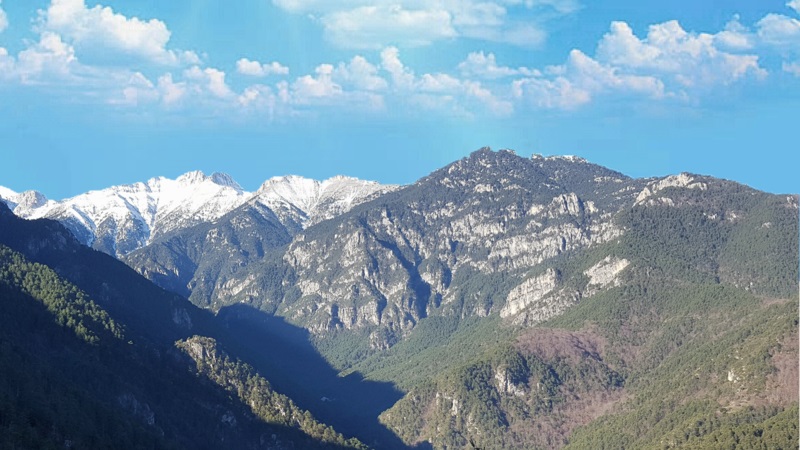Mount Áitna
"Home of the Gods"
Mount Áitna (/ˈɛt nə/, Kiltic pronunciation: [ˈæ:t nʌ, ˈɛtʃ nʌ]) is a mountain comprised of seven peaks and many deep gorges, located in Érevon's northern Cogatha region about 75 wmi. northeast of Carraighéar. The tallest of its seven summits, known as the Airdthéla (Heights of Teagla), rises to 6,769 yds. above mean sea level, making it the tallest mountain peak in Érevon, and the highest point in the Everlian range of the Cúlláidir mountain chain. In ancient times it marked the border between Érevon and the Frankish tribes of the north.
Áitna is described in Kiltic mythology as the “home of the gods,” or more specifically the home of the Áitnaian gods -- the older, more powerful gods who were believed to reside on the Airdthéla when not moving about the mortal world. As a result of its mythological connection with the Kiltic gods, Mount Áitna was also known in ancient times as Tairseach Neamhaí or the “heavenly threshold.”
In addition to its historical and cultural significance, Mount Áitna is also known for its natural beauty, recreational opportunities and wide variety of flora and fauna. Each year thousands of domestic and international tourists flock to the mountain to hike its slopes, explore its gorges, climb its peaks and take in its breathtaking vistas. The most popular destination for mountaineers intent upon summiting the peaks is the town of Clochrua in the southern foothills.
A second proposition supposes the name derives from áit naofa (holy place), from Old Kiltic naomh (holy, blessed), from Proto-Kilto-Agnomic noth (healthy, whole).
Dorosofios of Heracla (c. 491 – c. 433 BCS) describes the mountain as the “refuge of the Kiltic gods” in his Istoría Kósmou (History of the World). Lachtna Trashúil (50 BCS – 17 CA) refers to the mountain as Aith n’Déthaigh in his Tíreolaíocht (“Geography”).
Despite the rise of Sanctism and the decline of Kiltic Paganism, Mount Áitna has nevertheless maintained its cultural significance to the Érevish people. It retains its importance not only as a dominant physical feature of the Érevish landscape but also as an integral component of the Érevish cultural identity.
Áitna is described in Kiltic mythology as the “home of the gods,” or more specifically the home of the Áitnaian gods -- the older, more powerful gods who were believed to reside on the Airdthéla when not moving about the mortal world. As a result of its mythological connection with the Kiltic gods, Mount Áitna was also known in ancient times as Tairseach Neamhaí or the “heavenly threshold.”
In addition to its historical and cultural significance, Mount Áitna is also known for its natural beauty, recreational opportunities and wide variety of flora and fauna. Each year thousands of domestic and international tourists flock to the mountain to hike its slopes, explore its gorges, climb its peaks and take in its breathtaking vistas. The most popular destination for mountaineers intent upon summiting the peaks is the town of Clochrua in the southern foothills.
Etymology
The derivation of the name Áitna is uncertain. The more popular theory asserts it is a truncated contraction of the mountain’s ancient name, Áit na Déithe (place of the gods), from Old Kiltic áith (place, situation, position) + Old Kiltic dé (god, genitive plural = n’déthaigh, hence of the gods).A second proposition supposes the name derives from áit naofa (holy place), from Old Kiltic naomh (holy, blessed), from Proto-Kilto-Agnomic noth (healthy, whole).
History
Mount Áitna appears in the historical record from earliest times, and has apparently always been associated with the older gods of the Kiltic pantheon. In his epic poem An Scéal Faoi Thógáil Érevonaigh (The Tale of the Taking of Érevon), Oisín na Daill refers to the mountain over 272 times, both as Áitha na Déthaigh (place of the gods) and as anToirseach Neamhaínna (the heavenly threshold).Dorosofios of Heracla (c. 491 – c. 433 BCS) describes the mountain as the “refuge of the Kiltic gods” in his Istoría Kósmou (History of the World). Lachtna Trashúil (50 BCS – 17 CA) refers to the mountain as Aith n’Déthaigh in his Tíreolaíocht (“Geography”).
Despite the rise of Sanctism and the decline of Kiltic Paganism, Mount Áitna has nevertheless maintained its cultural significance to the Érevish people. It retains its importance not only as a dominant physical feature of the Érevish landscape but also as an integral component of the Érevish cultural identity.




Comments